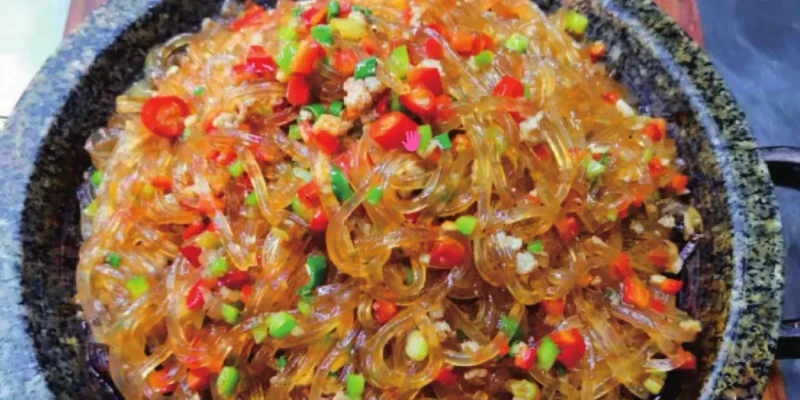
Ants Climbing a Tree is a classic Sichuan noodle dish featuring glass noodles and minced pork in a savory, spicy sauce. The noodles resemble tree branches, while the minced pork looks like ants, giving the dish its unique name. Its springy texture and bold flavors make it a favorite for those seeking authentic Sichuan comfort food.
Well, let's first get a basic understanding of how to make this delicious dish through this AI tutorial.
The tutorials provided by AI can only be used as references. In the actual practice process, remember to proceed according to the actual situation.
🧆 Ingredients
- 100g glass noodles (mung bean vermicelli)
- 100g minced pork
- 1 tablespoon doubanjiang (spicy bean paste)
- 2 cloves garlic (minced)
- 1 thumb ginger (minced)
- 2 green onions (chopped)
- 1 tablespoon soy sauce
- 1 tablespoon Shaoxing wine
- 1 teaspoon sugar
- 1 cup chicken stock
- 1 tablespoon vegetable oil
- Salt to taste
🍳 Steps
-
Prepare the Ingredients:
- Glass Noodles: Place the glass noodles (mung bean vermicelli) in a large bowl and cover with warm water. Let them soak for 15–20 minutes until fully softened and pliable. If the noodles are too long, cut them into manageable lengths with kitchen scissors after soaking. Drain thoroughly before cooking.
- Minced Pork: Choose pork with a bit of fat for better flavor and texture. If using whole pork, finely mince it with a knife or food processor. Pat dry with a paper towel to remove excess moisture.
- Aromatics: Peel and finely mince the garlic and ginger. Chop the green onions, separating the white and green parts for different stages of cooking.
-
Cooking the Pork and Aromatics:
- Heat a wok or large skillet over medium-high heat. Add the vegetable oil and swirl to coat the pan.
- Add the minced garlic and ginger, and stir-fry for about 30 seconds until fragrant but not browned.
- Add the doubanjiang (spicy bean paste) and stir-fry for another 30 seconds to release its aroma and color the oil.
- Add the minced pork, breaking it up with a spatula. Stir-fry until the pork is no longer pink and starts to brown slightly, about 2–3 minutes. The pork should be crumbly and evenly coated with the sauce.
-
Building the Sauce:
- Pour in the soy sauce, Shaoxing wine, and sprinkle in the sugar. Stir well to combine.
- Add the chicken stock and bring the mixture to a gentle simmer. Taste and adjust salt if needed.
- Simmer for 2–3 minutes to allow the flavors to meld and the sauce to reduce slightly.
-
Cooking the Noodles:
- Add the drained glass noodles to the wok. Use tongs or chopsticks to gently toss and separate the noodles, ensuring they are evenly coated with the sauce.
- Stir-fry for 2–4 minutes, allowing the noodles to absorb the sauce. If the mixture becomes too dry, add a splash of water or more chicken stock.
- The noodles are done when they are translucent, springy, and have absorbed most of the sauce. Taste a noodle to check for doneness; it should be tender but not mushy.
-
Finishing Touches:
- Add the chopped white parts of the green onion and stir-fry for another 30 seconds.
- Remove from heat and transfer to a serving dish.
- Garnish with the green parts of the green onion.
Additional Tips for Success:
- Ingredient Quality: Use high-quality glass noodles for the best texture. Freshly minced pork yields better flavor than pre-ground.
- Spice Level: Adjust the amount of doubanjiang to your preferred spice level. For extra heat, add a pinch of chili flakes.
- Prevent Sticking: Stir the noodles constantly after adding to the wok to prevent sticking and ensure even sauce absorption.
- Serving: Serve immediately while hot for the best texture and flavor. This dish does not reheat well as the noodles may become soggy.
How to Judge Doneness:
- The pork should be fully cooked, crumbly, and slightly browned.
- The noodles should be translucent, springy, and flavorful, with no hard core remaining.
- The sauce should be mostly absorbed, coating the noodles and pork evenly.
Cleaning and Preparation:
- Rinse all vegetables and aromatics under running water before chopping.
- Use separate cutting boards for meat and vegetables to avoid cross-contamination.
- Clean the wok or skillet thoroughly before starting to prevent off-flavors.
💡 Tips
- Use glass noodles for authentic texture.
- Adjust doubanjiang for desired spice level.
- Stir-fry quickly to prevent noodles from sticking.
- Serve immediately for best flavor.
🗺️ Where to Try Ants Climbing a Tree
After reading this tutorial, do you feel that making it at home is complicated and time-consuming?
Wondering where in Tulsa you can easily enjoy authentic Ants Climbing a Tree?
Just click 

